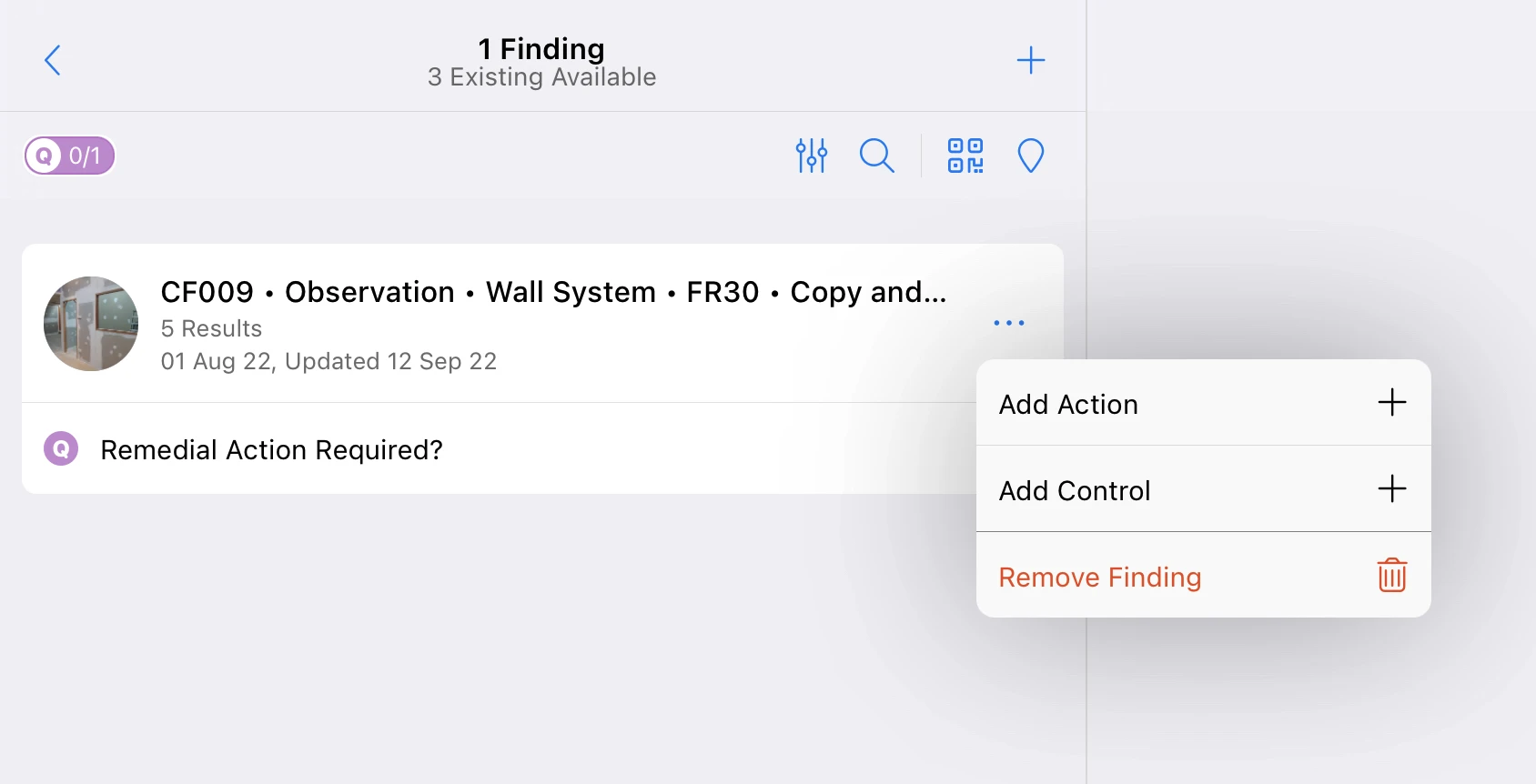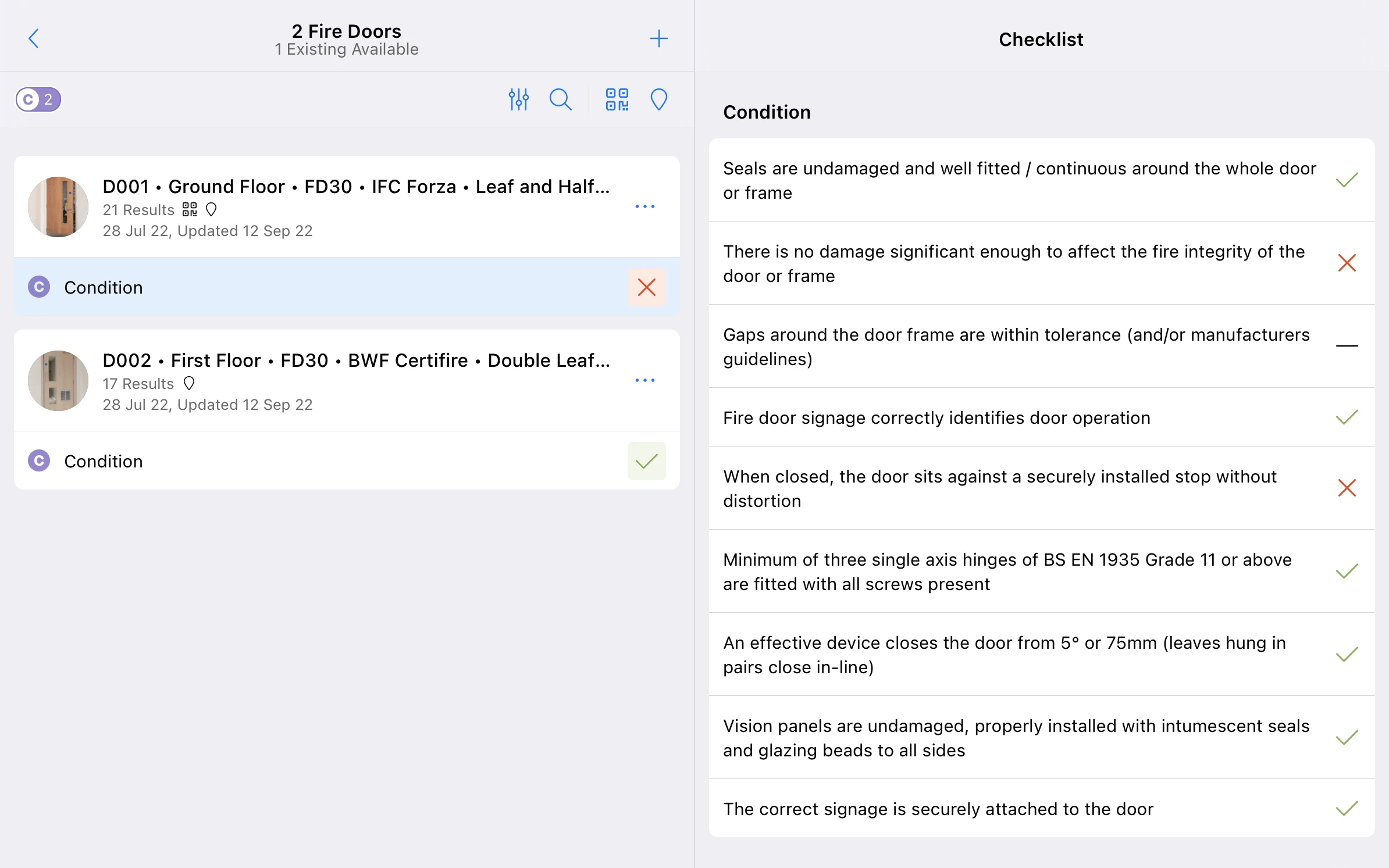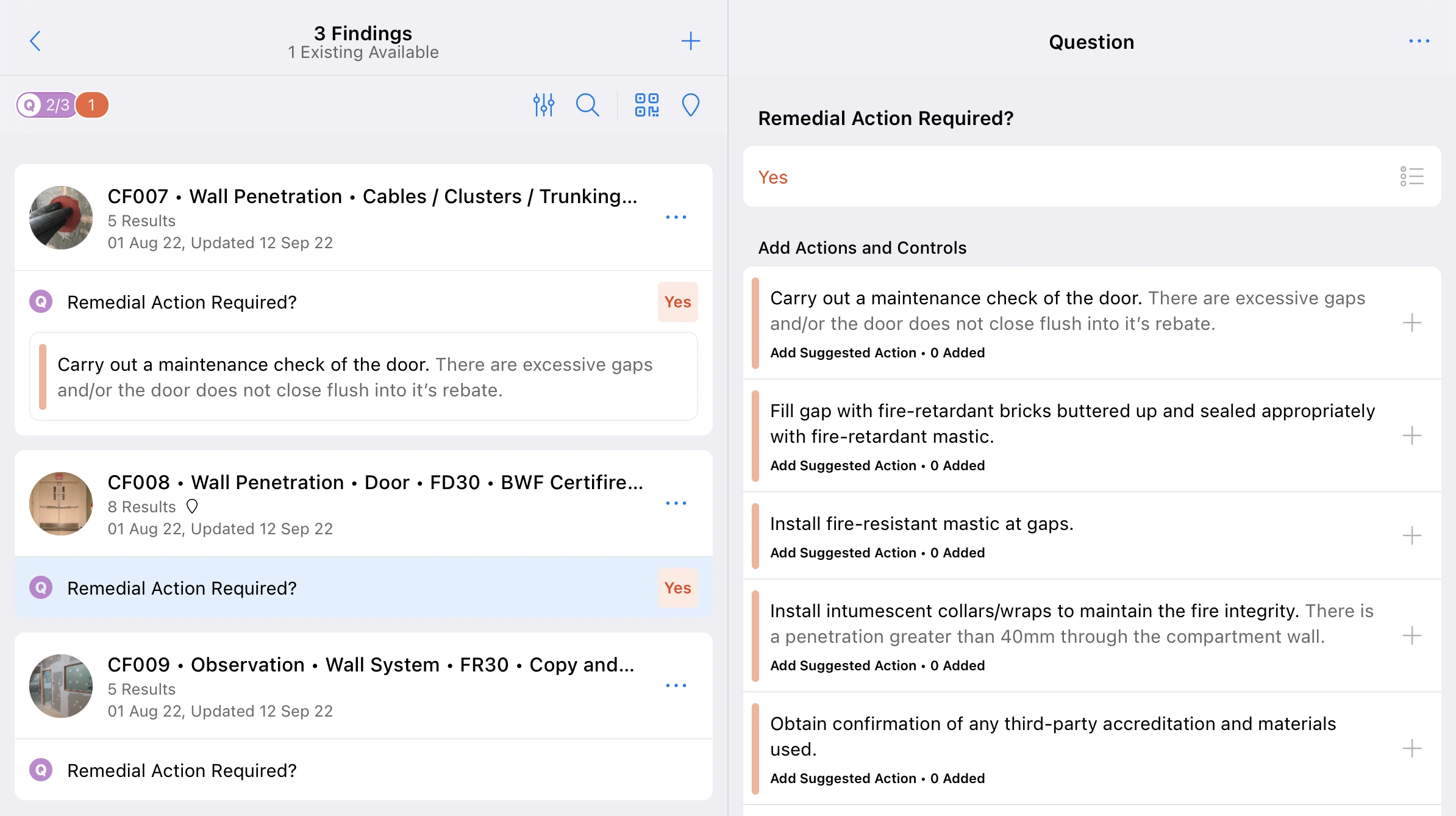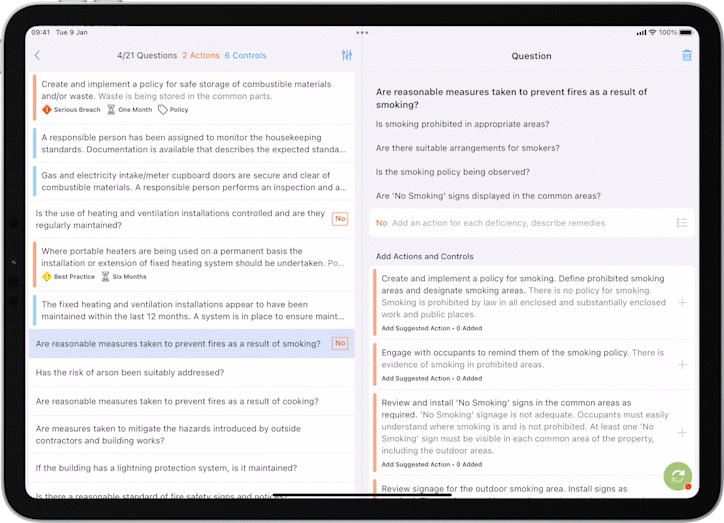?999 Updates
Product Update
New Products
New tools have made it possible to improve the way in which survey data is collected and reported. Using a mix of fields, questions, and checklists we've created a range of off the shelf survey and audit products:
- Fire Door
- Compartmentation
- Exterior Wall
- Fire Extinguisher
- Health and Safety
- Legionella
Like everything RiskBase, our products are infinitely customisable. You can use app.RiskBase's template builder to modify each element.
For information on any of our new products, email support@riskbase.uk.
Actions on Repeatables
Actions and controls can be added to repeatable fields. We use this to power our compartmentation surveys. After collecting penetration information and material observations, you can add actions where required just as you do with Fire Risk Assessments.

Attach Questions and Checklist to Repeatable
Questions and checklists can be linked to a repeatable field. We use the to power our Door Surveys. Once you've collected or reviewed static information about a door, you complete a conditional checklist.

Because checklists and questions a linked to repeatables, suggested actions and controls are available too.

Reports
When you add fields to your assessments you are also controlling which fields appear on your reports. Choosing which fields to include and which to omit is something new for RiskBase users.
With huge variety in the types of data that can be collected, reporting becomes tricky. An electrical FRA finding needs to be presented in very different way to a door in a fire door survey. For each data type, we ask "What does a customer need to see and how can we best explain its implications?". Following that, we create custom PDF layouts for each one of our field types.
Billing - A Win For Us All
Now fields are in assessments, we can count the number of repeatables you add. We can bill for the exact number of doors, fire extinguishers or compartmentation findings you include in your surveys. You end up paying a fair price for each assessment you approve.
Published 26 September 2022Fields In Assessments
Fields can now appear and be edited inside assessments. You can add and update information about your asset alongside answering questions and adding actions and controls.
This makes completing risk assessments more efficient because you no longer need to leave the assessment to add information about an asset.

You can still add and modify field information outside of an assessment on the asset page.
Field data added during an assessment is saved to the asset when you press submit.
Add Fields To Your Assessment Templates
Learn how to set up fields in your assessments.
Published 12 September 2022Continually Improving Your Experience
We strive to provide the best assessment workflow and because there are always improvements to be made we continue refining.
Our latest update includes a range of user interface changes that delivers marked efficiencies to everyone performing assessments and surveys.
Modal View When Adding Actions
Jumping from page to page disrupts the flow of data collection so when answering questions you now input everything on a single page.
Press to add an action and a modal view pops up where you can provide the 'What', 'Why', 'Location' and supporting photos. Press Save and the modal view descends taking you right back to where you started.
- The modal view focusses your attention on the elements of your actions and controls.
- Pressing save provides a mental confirmation that they've been added to your assessment.
- Returning back to the question where you left it saves a whole lot of scrolling and time.

Modal view is used across RiskBase App enabling you to work faster when:
- Downloading Assets.
- Adding photos from your photo library.
- Updating profile information.
Regular updates are pushed automatically to your device. Everytime you are prompted to press Update, a bug fix or new feature has just improved your RiskBase experience.
We're reviewing Terminology to make RiskBase more intuitive for new and seasoned users alike. We are favouring desriptive words and dropping confusing terms.
Some of the terminology changes we've made so far
-
Severity. This is the first step to prioritising an action. It explains how serious the consequences of ignoring a hazard could be. This used to be called Secondary Priority.
-
Timescale. This is the second step to prioritising an action. It defines how quickly the action should be completed. This used to be called Priority.
-
Suggested Action. Previously known as Template Action. When you answer a question negatively, RiskBase suggests actions to you.
-
Suggested Control. Previously known as Template Control. When you answer a question, RiskBase suggests controls to you.
-
Custom Action/Control. The custom has been dropped. If none of the suggested actions or controls are relevant, press Add Action or Add Control to create one from scratch.
We release larger updates a few times a year via the Apple app and Google play stores. If your device automatically updates your apps, you'll always be on the latest version of RiskBase.
Visual Cues help us navigate assessments, process the things we're seeing and make quicker decisions so we've introduced new, more striking icons to RiskBase App.
A good example is the icons we have added to actions. You can learn a lot about an action at a glance.
- Severity. Exclamation icon. Colour scale provides further insight.
- Timescale. Sandtimer icon.
- Category. Label icon.
- Location. Compass icon shows if a location has been specified.
- Photo. Picture icon shows if photos have been attached to the action or control.
![]()
When Reviewing actions and controls from previous assessments, the new statuses are displayed.

What Do You Think? Whether we are introducing brand new functionality, minor efficiencies or you have a brilliant idea, we want to hear from you. Drop us an email.
Published 11 March 2022?998 Fields In Assessments
Fields can now appear and be edited inside assessments. You can add and update information about your asset along side answering questions and adding actions and controls.

This makes risk assessment workflows more efficient but also provides opportunities for collecting and reporting more complicated findings.
You can still pre fill fields with asset information on the asset page, before beginning an assessment.
Field data added during an assessment is saved to the asset when you press submit.
New Products
New tools have made it possible to improve the way in which survey data is collected and reported. Using a mix of fields, questions and checklists we've created a range of off the shelf survey and audit products:
- Fire Door
- Compartmentation
- Exterior Wall
- Fire Extinguisher
- Health and Safety
- Legionella
Like everything RiskBase, our products are infinitely customisable. You can use app.RiskBase's template builder to modify each element.
For information on any of our new products, email support@riskbase.uk.
Actions on Repeatables
Actions and controls can be added to repeatable fields. We use this to power our compartmentation surveys. After collecting penetration information and material observations, you can add actions where required just as you do with Fire Risk Assessments.

Attach Questions and Checklist to Repeatable
Questions and checklists can be linked to a repeatable field. We use the to power our Door Surveys. Once you've collected or reviewed static information about a door, you complete a conditional checklist.

Because checklists and questions a linked to repeatables, suggested actions and controls are available too.

Reports
When you add fields to your assessments you are also controlling which fields appear on your reports. Choosing which fields to include and which to ommit is something new for RiskBase users.
With huge variety in the types of data that can be collected, reporting becomes tricky. An electrical FRA finding needs to be presented in very different way to a door in a fire door survey. For each data type, we ask "What does a customer need to see and how can we best explain it's implications?". Following that, we create custom PDF layouts for each one of our field types.
Billing - A Win For Us All
Now fields are in assessments, we can count the number of repeatables you add. We can bill for the exact number of doors, fire extinguishers or compartmentation findings you include in your surveys. You end up paying a fair price for each assessment you approve.
Add Fields To Your Assessment Templates
See instructions on setting up fields in assessments.
Published 8 September 2022